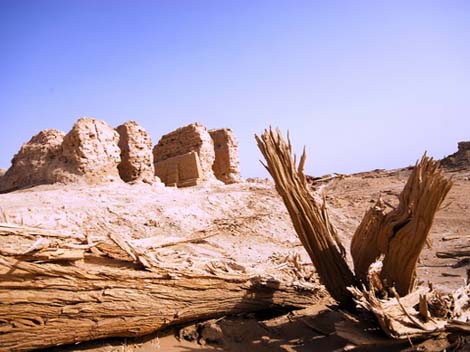(Ecns.cn)--Li Pengfei stood in silence surveying the land he safeguards - the ruins of the legendary city of Loulan where he and others believe numerous treasures may be buried underfoot.
Meanwhile, the Guangzhou Daily reported a nonprofit group with the mission of "Safeguarding the national treasure of Loulan" had left that city early in the morning of October 27 to make its way to this vanished but once prosperous kingdom in Xinjiang Uyghur Autonomous Region.
A wealth of enigmas
Loulan refers to an ancient kingdom on the west bank of Lop Nur in the midst of dessert, but it was centered on a city that flourished around a significant oasis. By the second century B.C., Chinese historical records show it was already an important state along the Silk Road, and at its peak Loulan's population reached over 50,000.
The picture is totally different today. Lop Nur, a salt water lake, finally shriveled into a dry bed. Lop Nur is a forbidden zone to all forms of life now, and people seldom have reason to visit it.
The vanished hub of commerce left only a wealth of enigmas for later generations to puzzle over. Then traces of Loulan finally surfaced a century ago when Swedish explorer Sven Hedin stumbled on the ruins of an ancient city largely submerged by desert sands.
Loulan revisited
The Guangzhou team reached the Loulan Preservation Station of Cultural Relics on October 29, after a long journey of 5,000 kilometers. Only four Chinese work at this remote site full time, solely to safeguard cultural relics.
The site is almost unlivable, and its full time guards taste the bitterness of the lonely. No residents or vehicles move in the seemingly endless dissert. The howling winds even feel like company in this eerily quiet area. "Some newcomers chose to leave immediately after spending just one night in this place." said Cui Yousheng, one of the four protectors.
The summer brings especially tough times; the surface temperature can climb to 80 degrees Celsius, driving the brave foursome into the rough conditions of a cooler underground cave.
Around the preservation site stand a huge array of ancient tombs. To give them the jump on robbers, the four protectors have buried some sharp and hardly-noticeable nails into the pathways leading to the tomb zone, sure to deter or disable motorcycles or cars that try to approach.


















